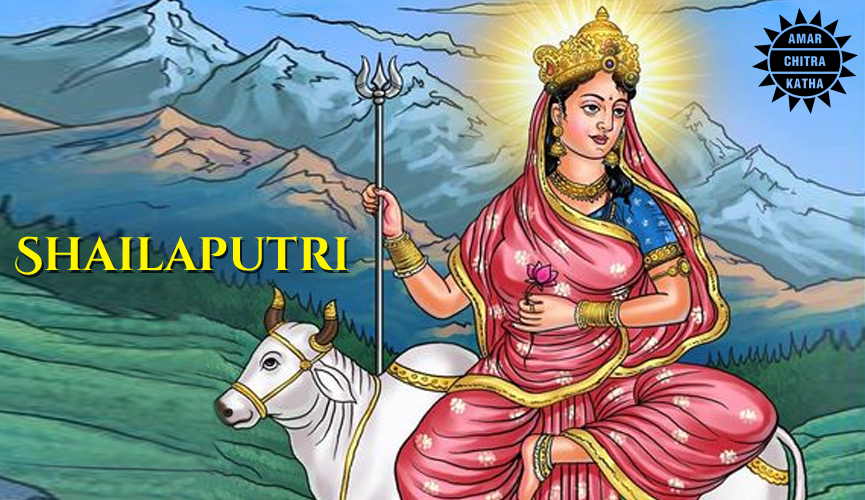The first day of Navratri celebrates Devi Shailaputri who is also known as Adi Parashakti. She is the daughter of the king of mountains and the reincarnation of Goddess Sati. Born to King Himavat, Devi Shailaputri’s name literally translates into daughter (“putri”) of the mountain (“shaila”). Representing the purest form of Goddess Parvati, Shailaputri Devi is the first of the Navdurgas (nine manifestations of Durga) to be worshipped during Navratri.
The story of Devi Shailaputri begins with Devi Sati who was the daughter of Prajapati Daksha, and Shiva’s first wife. Displeased with her father’s callous treatment of her husband, Devi Sati self-immolated after stating her wish to be reborn or reincarnated to worthier parents. She was then born to King Himavan as Goddess Parvati and went on to marry Lord Shiva once more.

Goddess Shailaputri, or Parvati, is depicted wearing the crescent moon on her head, holding a trident in her right hand and a lotus in her left, and she is seated upon the back of the bull, Nandi. Each of these elements holds a symbolic significance: the moon symbolises the infinity of nature and consciousness, the blooming lotus signifies peace, purity and awakening; the trident with its three prongs represents the past, present and future, while Nandi signifies determination and single-minded devotion, particularly to Lord Shiva.
Devi Shailaputri is the giver of life and has power over nature. She sustains cycles, routines, and preserves the natural order of the universe. The embodiment of Shakti, Parvati is said to be the ultimate Mother Goddess, the source, and the manifestation of all power of the Trimurti – Brahma, Vishnu, and Shiva.
Devi Shailaputri is associated with the Muladhara Chakra, or the root chakra, the starting point of spiritual discipline. It is said that on the first day of Navratri, Devi Shailaputri, seated upon Nandi’s back, begins her upward journey towards her Shiva, who is seated in the Sahasra Chakra – the crown chakra – with all of her focus on him and on attaining him.
This is why, for Yogis and ardent devotees, the first day of Navratri is extremely auspicious, and is considered the ideal day for spiritual awakening. People commonly observe fasts on this day, either sticking to a meal of only fresh fruit, or eating very sparse meals that have been prepared especially for fasting.
It is also very common for devotees to wear a specific colour on each day of Navratri. This year, the designated colour on the first day of Navratri is yellow.





